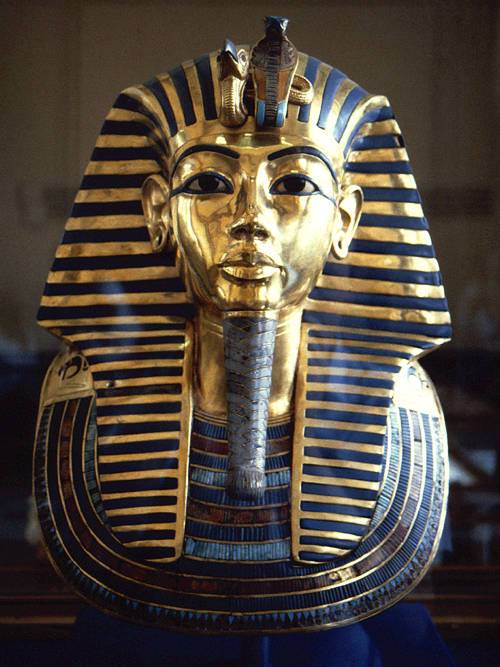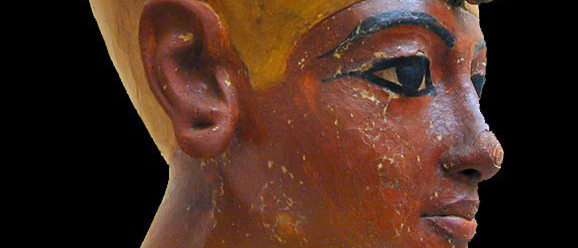This is a review of an old exhibition tucked away unobtrusively at the back of Oxford’s Sackler Library. The Griffith Institute of Egyptology is the home of the complete Howard Carter archives, documenting the discovery and ten-year excavation of the tomb of Tutankhamun. In 2014 the Institute celebrated its 75th anniversary, and so the Ashmolean’s hosted an exhibition, Discovering Tutankhamun, that explored the excavation and its aftermath using material from the Griffith’s archives.
The exhibition started with an introduction to Howard Carter and Lord Carnarvon, followed by an explanation of the progress of the excavation, illustrated with large-scale graphics panels showing photographs from the time (including a great one of Carter and various visitors sitting down to dinner at a fully-laid table in a nearby empty tomb, of which I sadly can’t find a copy on the internet) and archival materials such as Carter’s diary entry describing the discovery, letters from Lord Carnarvon, and a plan of the tomb and its contents. Next there’s a section on the cultural impact of the discovery and the ‘Tutmania’ which followed: Tutankhamun board games, clothes, ornaments, magic shows, popular songs, you name it. The highlights of this room were the original footage of activity outside the tomb — visitors arriving, conservation work, artefacts being transported to storage — and the cases of letters written to Carter by members of the public, from six-year-old aspiring Egyptologists to people requesting souvenirs (in one case, enclosing a shilling postal order to cover the costs of shipping an artefact) or, following Carnarvon’s death, offering advice on how to break the ‘curse of the mummy’. The last room has the only ancient artefacts on display (apart from a few pots near the beginning), with a series of sculptures used to illustrate the Amarna period, Tutankhamun’s subsequent reign, and those of his successors, followed by a look at the future of the tomb and prospects for research on it using the Griffith’s archives.

The Mask of Tutankhamun. Wikipedia
Unfortunately, the exhibition really doesn’t have anywhere near enough material to justify occupying the whole of the Ash’s special exhibitions floor. The first part looks nice, with all the graphics, and gives a perfectly adequate basic account of the excavation, but little more than that – there are very few archival documents actually on display, and although the text stresses the archaeological process (with sections on documentation, photography, and conservation), there’s actually very little detail about the processes, and it doesn’t give any sense of how Carter’s methods relate to usual practice at the time. The ‘Tutmania’ section is entertaining enough, but rather superficial, and the sudden leap back to the Amarna period in the next room is unexpected – combining the Tutmania and future prospects sections at the end would have given a better flow to the whole exhibition. This last room was by far the weakest section: the account of the profound changes to Egyptian religion introduced by Tutankhamun’s father Akhenaten during the Amarna period and their subsequent reversal by Tutankhamun himself was extremely limited and illustrated only by very fragmentary bits of sculpture, while future prospects for research, to go by the final section, are apparently limited to the creation of an exact replica of the tomb at Luxor to save wear and tear on the original. Only in the very final text panel by the exit do we learn that two-thirds of the objects found by Carter have still not been properly studied, and that the archives are therefore of huge importance for current and future archaeological research as well as historical interest.
It’s a difficult thing to put on an exhibition based primarily on archival material — particularly in the case of Tutankhamun, when the original artefacts are so well-known and so stunning that almost any exhibition about the subject is in danger of being overshadowed by their absence. But for me, the real problem with this exhibition was that, in trying to avoid an exhibition ‘just full of bits of paper’ and create a blockbuster, it didn’t just suffer from a lack of ancient objects, but more fundamentally forgot what it was supposed to be celebrating. I left the museum with very little sense of the extent or importance of the Griffith’s collections – I’d like to have seen more of the archival material, and for it to have been given more prominence (for instance, in the ‘Tutmania’ room, I suspect almost no-one stopped to read the letters, because they were in difficult handwriting and no transcriptions were provided – which is a great shame). I’d also have liked a sense of how the archives are contributing to modern research – perhaps some case-studies of current/recent work on them (there must be Oxonian Egyptology fellows or PhD students using them, surely?). So while I had a perfectly good time pottering around this exhibition, I’d suggest just browsing the Griffith’s excellent
So while I had a perfectly good time pottering around this exhibition, I’d suggest just browsing the Griffith’s excellent digital archive instead.

